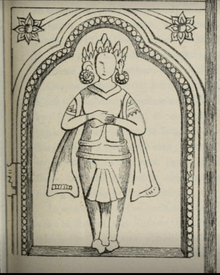Tamresari Temple
Tamresari temple, also known as Tamasari Mai[1], Kesai Khaiti, is situated about 18 km away from Sadiya in Dibrugarh district now Tinsukia district, Assam, India. The temple was worshiped by Deoris. It is the remains of an old temple built by the Chutiya kings. The original Assamese word is Kechaikhaiti (kechai means raw and khaiti means eat), refers to a Goddess, a version of Goddess Kali, who accepts offerings of raw meat, hence the name (someone who eats raw).[2]
Stone inscription
The stone inscription found in the temple reads,[3]
“Shiv-Charan-Prasadat Vridharajatan
Ya-Sri-Srimata-Mukta Dharmanarayana
Shri shrimati Digaravasini Ichtaka
Di-Virchit-Prakara-Nivaddha
Krit Agrahainike Saka 1364”— Tamresari Wall inscription
The inscription describes that the walls of the temple have been built using bricks(Ichtaka) by the son Mukta Dharmanarayan of the old king(name not specified) in the Saka year 1364(1442 AD). The temple is said to be dedicated to the goddess Digarabaxini(Kechai-khati) which finds mention in the 9th-10th century text Kalika Purana as a Kamrupa pitha.
The name Tamresari
The wall and doors of the temple were well designed with beautiful works. There were two giant elephant sculptures with silver tusks at the main door. The walls were made without any mortar. The temple roof was made of copper(tam in assamese), that's why it is called Tamreswari. The whole temple was surrounded with brick walls and on the western wall there was a place for human sacrifice.[4]
Architecture
The roof of the Tamresari temple was originally sheeted with copper as mentioned in the Changrung Phukan Buranji(1711 AD), from which the name is derived. In 1848, when Dalton visited the site, he found a stone structure, but the copper roof was already removed. As per T.Block who visited the site in 1905, this square structure in the corner cannot have been the main building inside the complex and the brick wall evidently enclosed some sort of a grand temple in the center which has disappeared with time. The Kalika Purana mentions that the temple was octagonal in shape with eight Dwarpalas(namely Narantaka, Tripurantaka, Devantaka, Yamantaka, Vetalantaka, Durdharantaka, Ganantaka and Sramantaka). According to S.F. Hannay, the present temple complex was as near as possible square with the doorway to the west. There was a substantial brick wall, about 4.5 feet thick rising to the height of 8 feet, on the foundation of rudely cut blocks of sandstone. The entrance of the complex was on the west face, where there had been a stone enclosure and door. The ruins of the gateway which remains include the lintel carved on the edge in a chain of lotus flowers, some ornamented small pillars and an elephant statue. The three blocks forming the doorway, each of 7.5 feet long and 2 feet by 18 inches in girth, along with the blocks of the projecting wall, were reddish porphyritic granite of an adamantine hardness. There was another stone gateway at the southeast corner leading to the stream, in the bed of which are several carved and plain blocks of granite and sandstone.[5] According to Debala Mitra(1956), the temple was originally Chaturayatana, i.e. having four shrines, built of sandstone and granite and located in the south-east section of the rectangular brick enclosure, prakara roughly measuring 208 ft by 130 ft. The compound wall was 4 feet wide and 8 feet tall and had a stone gateway on the eastern side. In the floods of 1959, due to deposit of silt in the banks of Paya river the structure was completely submerged in the waters. [6]

References
- Leslie Shakespear,History of Upper Assam, Upper Burmah and North-East Frontier, p.24
- Dibyajyoti Sarma. "salt, sweat, smell". Retrieved 12 June 2015.
- Sircar,D.C,Journal of Ancient Indian History, p. 21.
- "Sadiya - Tourism, History, Culture and other facts". Retrieved 12 June 2015.
- Hanney, S.F. Journal of the Asiatic Soceity of Bengal p. 468.
- Religious history of Arunachal Pradesh by Byomkesh Tripathi